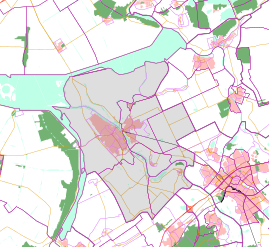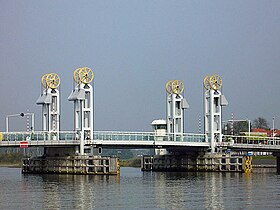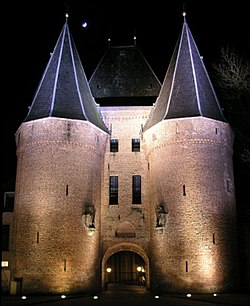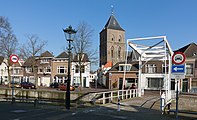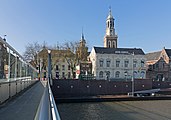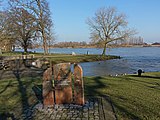Kampen (Netherlands)
 flag |
 coat of arms |
| province |
|
| mayor | Bort Koelewijn ( CU ) |
| Seat of the municipality | Kampen |
|
Area - land - water |
161.84 km 2 141.45 km 2 20.39 km 2 |
| CBS code | 0166 |
| Residents | 53,869 (Jan 31, 2019) |
| Population density | 333 inhabitants / km 2 |
| Coordinates | 52 ° 33 ' N , 5 ° 54' E |
| Important traffic route |
|
| prefix | 038, 0525 |
| Postcodes | 8260-8279 |
| Website | Homepage of Kampen |
Kampen ( ) is a municipality and former Hanseatic city in the Dutch province of Overijssel with an area of 161.84 km² and 53,869 inhabitants.
places
Population in brackets (January 2007):
- Kampen; Seat of the municipal administration (33,750)
- IJsselmuiden , on the right bank of the IJssel opposite Kampen (11,500)
- Grafhorst (1,000)
- 's-Heerenbroek (600)
- Kamperveen (just over 800)
- Wilsum (just over 800)
- Zalk (just over 800)
Location and economy
The city lies at the mouth of the IJssel in the Ketelmeer . This 35 km² lake is connected to the larger IJsselmeer . Kampen has three traffic bridges over the IJssel. The city is the end point of a small train to Zwolle ; the train station is on the other bank of the river, opposite the city. Due to the excavation of the Reevediep, the Hanseatic city of Kampen and two small towns are no longer on a peninsula , but on a river island and can only be reached via bridges and a tunnel .
Kampen has two theological faculties from various Protestant churches and an art academy . Agriculture, especially dairies (in the surrounding polders with nutrient-rich meadows), and various smaller industrial companies and shipyards as well as tourism (water sports; historic old town) are the main sources of income.
traffic
Kampen is on the N50 . The N50 will be converted into the A50 in the future. Kampen can also be reached by train from Zwolle . The line was previously part of the Utrecht-Kampen route. Kampen station (north) is the station at the Kamperlijntje . The railway line should be converted for trams from 2012; Kampen should get an additional train station Kampen Oost. These plans have been put on hold because they are too expensive. At the end of 2012, the Hanzelijn , a railway line between Lelystad and Zwolle, on which the Kampen Zuid train station is located, was opened. Several bus lines also stop in Kampen: In 2008: line 74 (Kampen - Genemuiden - Hasselt - Zwolle), line 140 (Zwolle Campus - Dronten - Melisse), line 141 (Zwolle - Emmeloord - Urk ), line 143 (Kampen - Dronten - Lelystad), and the Hanzelijner. However, the situation changes every year; more and more bus routes are falling victim to austerity measures. There are also urban lines 11 and 12. For some years now, Kampen has also had the so-called Zuiderzeehaven, a new 50 hectare port.
history
middle Ages
Kampen, also spelled Campen , emerged around the year 1000 from a village along a dike. In 1236 Kampen received town charter , which it probably already exercised in accordance with customary law.
Kampen was an important port and trading city early on because of its location at the river mouth. Herring was shipped from Kampen to the Rhine region, Westphalia, Flanders, France, England, Denmark, Norway and the Baltic Sea states. Among other things, Kampen was certified by Norway in 1289, England in 1294, Flanders in 1295 and Sweden in 1313. In 1323 the city concluded a contract with the municipality of Terschelling to protect the entrance and they received permission to set up a sea mark. In the economic struggle between the Hanseatic League and Flanders from 1358 to 1360, Kampen sided with Flanders and received the Groot Privilege van Vlaanderen in 1361 . The city then joined the Hanseatic League in 1441 (the Hanseatic letter was lost in the town hall fire in 1543). For some time Kampen was the most important Dutch city in this urban network and worked closely with the twin cities Deventer and Zwolle . In the 15th century the three cities had a common coin.
In 1416 it was reported that Kampen had 120 schepen bi the lake and had 9000 communicants, thus probably around 12 to 14,000 inhabitants, so it was as big as Amsterdam .
In the 14th century there was a cloth industry on site and in 1335 a wanthues of cloth merchants and waardijns (goods inspectors ). The art of bell foundry from Kampen was also known towards the end of the 15th century. The famous Dutch bell founder Geert van Wou (1440–1527) worked here. But cannons were also cast.
In 1448 the first bridge was built over the IJssel. A new city canal was necessary because of the increasing population. The fairway to the sea had to be expanded. The medieval St. Nicholas Church and the Church of Our Lady were expanded, the old town hall was built, as well as monasteries, brotherhood houses, plague houses and hospitals. The guilds were important institutions in the city.
Modern times
Since the 15th century, Kampen lost its importance because of problems with the water level. But the consequences of wars, the decline of the Hanseatic League and trade competition with Holland also contributed to the fact that the city was only able to develop to a lesser extent. In the 16th century, cargo ships from Kampen were reported in the Baltic Sea cities as well as in Bremen and Hamburg as well as in England. The Nieuwe Toren (New Tower) was built in the 17th century .
From the 19th century to around 1970, Kampen was a center of cigar production .
In 2017, Kampen was awarded the honorary title of “ Reformation City of Europe ” by the Community of Evangelical Churches in Europe .
Grafhorst and Wilsum
The places Grafhorst and Wilsum also received city rights in the Middle Ages, but never grew into real cities. Grafhorst was almost completely destroyed by a fire in 1849.
Attractions
building
- Town hall, with a beautiful interior, partly from the 16th century
- Three city gates, u. a. the Cellebroederspoort and the white Koornmarktspoort, which are visible from the IJssel
- New tower ( Nieuwe Toren ) from the 17th century, with four bells from the 1480s that came from another building and a carillon from the bell founder Hemony .
- Three old churches, of which the Nikolaus- or Upper Church (Bovenkerk) is particularly worth seeing. The Hinsz organ has become famous .
Only a few of the old houses have survived:
- The best known is the Gothic House , which housed the city museum until 2006. It was heavily restored in the 19th century by Pierre Cuypers .
- The IJsselfront , the row of houses along the river, dates from the middle of the 19th century.
Museums
- The municipal museum has the character of a larger local museum. In 2009 it received two new exhibition spaces in the old town hall and in the former synagogue . A large part of the collection of the former tobacco museum is now housed here.
- Temporary exhibitions are held in the Koornmarktspoort.
- Icon Museum .
- Nieuwe Toren with changing exhibitions
Sights outside the city
- Village church of Wilsum from the 11th century
- Zalk windmill (1860)
- IJsselmuiden village church (early 13th century)
- River and meadow landscape, rich in birds.
photos
Town twinning
The city of Kampen maintains city partnerships with the following cities:
-
 Eilat , Israel
Eilat , Israel
-
 Meinerzhagen , Germany
Meinerzhagen , Germany
-
 Pápa , Hungary
Pápa , Hungary
-
 Soest , Germany
Soest , Germany -
 Strzelce Opolskie , Poland
Strzelce Opolskie , Poland
Personalities
Honorary citizen
- Willem Kolff (1911–2009), medic and doctor; 1945 Kampen City Hospital, inventor of the artificial kidney .
sons and daughters of the town
- Hinrik van Kampen , bell founder of the 16th century
- Stephanus Winandus Pighius (1520–1604), prince educator at the court of Wilhelm the Rich in Düsseldorf, philologist and antiquarian
- Jan Willem de Winter (1761-1812), Admiral, Marshal, commander of the Dutch armed forces during the Napoleonic Wars
- Jean-Pierre Cluysenaar (1811–1880), architect
- Lucien von Römer (1873–1965), doctor, sexologist and botanist
- Mozes Slager (1880–1943), violinist
- Adriaan Schuurman (1904–1998), church musician, liturgist and music teacher
- Aleid Wolfsen (* 1960), lawyer and politician. Mayor of Utrecht since 2008
- Jaap Stam (* 1972), soccer player. He began his career at DOS Kampen and played there until 1992. Jaap Stam made 67 international matches for the Dutch national soccer team (1996-2004)
- Willy Kanis (* 1984), cyclist and bobsledder
- Roy van den Berg (* 1988), track cyclist
Personalities who have worked on site
- Hendrick Avercamp (1585–1634), painter, the mute of Kampen ( de Stomme van Kampen ); after him are Avercampstraat and a cafe named.
- Gerhard van Wou (1440–1527), bell founder . He created the Gloriosa for Erfurt Cathedral, which is generally considered to be his masterpiece.
Web links
- Website of the municipality (Dutch)
- Old postcards from Kampen (Dutch)
- Illustration by Frans Hogenberg from 1578. In: How the Hauptmann Ville nimptt instead of camping because of the states in ( digitized version )
- Illustration by Daniel Meisner from 1623. In: Camping. Ora Et Labora ( digitized version )
Individual evidence
- ↑ Bevolkingsontwikkeling; regio per maand . In: StatLine . Centraal Bureau voor de Statistiek (Dutch)
- ↑ Reevediep helemaal open voor recreatievaart. In: rtvoost.nl, accessed on December 31, 2019.
- ^ Johann Don: The Dutch Kampen as an old Hansa shipping and shipping city - a parallel case to Bremen. In: Bremisches Jahrbuch . Volume 51, 1969, ISSN 0341-9622 , pp. 67-63, Schünemann, Bremen 1969 ( online ).
- ^ Reformation city of Kampen. Netherlands. Philipp gave the starting shot. In: reformation-cities.org/cities, accessed on May 28, 2018.
- ↑ Wim Alings: Kentekens in stad en land . Nefkens, Utrecht 1978, p. 37.

